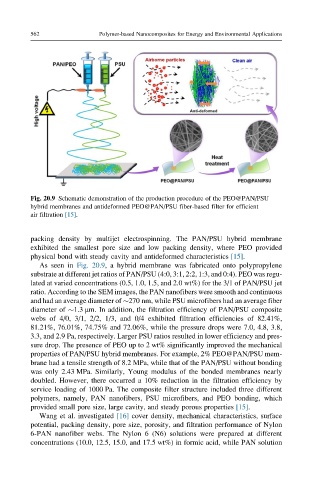Page 609 - Polymer-based Nanocomposites for Energy and Environmental Applications
P. 609
562 Polymer-based Nanocomposites for Energy and Environmental Applications
Fig. 20.9 Schematic demonstration of the production procedure of the PEO@PAN/PSU
hybrid membranes and antideformed PEO@PAN/PSU fiber-based filter for efficient
air filtration [15].
packing density by multijet electrospinning. The PAN/PSU hybrid membrane
exhibited the smallest pore size and low packing density, where PEO provided
physical bond with steady cavity and antideformed characteristics [15].
As seen in Fig. 20.9, a hybrid membrane was fabricated onto polypropylene
substrate at different jet ratios of PAN/PSU (4:0, 3:1, 2:2, 1:3, and 0:4). PEO was regu-
lated at varied concentrations (0.5, 1.0, 1.5, and 2.0 wt%) for the 3/1 of PAN/PSU jet
ratio. According to the SEM images, the PAN nanofibers were smooth and continuous
and had an average diameter of 270 nm, while PSU microfibers had an average fiber
diameter of 1.3 μm. In addition, the filtration efficiency of PAN/PSU composite
webs of 4/0, 3/1, 2/2, 1/3, and 0/4 exhibited filtration efficiencies of 82.41%,
81.21%, 76.01%, 74.75% and 72.06%, while the pressure drops were 7.0, 4.8, 3.8,
3.3, and 2.9 Pa, respectively. Larger PSU ratios resulted in lower efficiency and pres-
sure drop. The presence of PEO up to 2 wt% significantly improved the mechanical
properties of PAN/PSU hybrid membranes. For example, 2% PEO@PAN/PSU mem-
brane had a tensile strength of 8.2 MPa, while that of the PAN/PSU without bonding
was only 2.43 MPa. Similarly, Young modulus of the bonded membranes nearly
doubled. However, there occurred a 10% reduction in the filtration efficiency by
service loading of 1000 Pa. The composite filter structure included three different
polymers, namely, PAN nanofibers, PSU microfibers, and PEO bonding, which
provided small pore size, large cavity, and steady porous properties [15].
Wang et al. investigated [16] cover density, mechanical characteristics, surface
potential, packing density, pore size, porosity, and filtration performance of Nylon
6-PAN nanofiber webs. The Nylon 6 (N6) solutions were prepared at different
concentrations (10.0, 12.5, 15.0, and 17.5 wt%) in formic acid, while PAN solution

